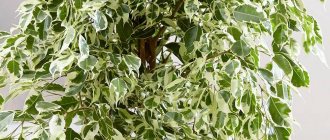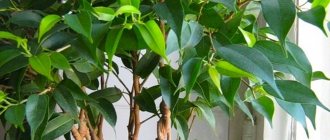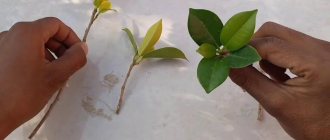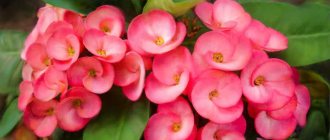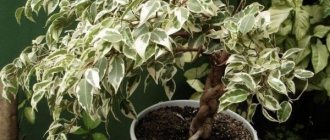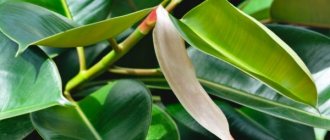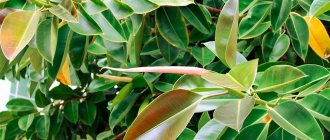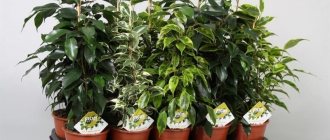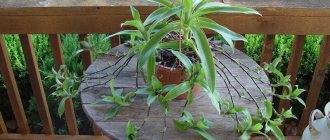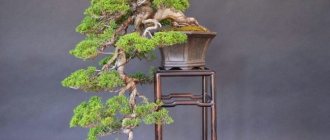Among capricious houseplants, Ficus Benjamin occupies a special place. Indeed, in any incomprehensible situation, a beautiful and lush tree instantly sheds its leaves. But the belief is that if you handle a sensitive guest with care, the ficus will definitely bring happiness and health to the house! So why not try it?
Botanical description
Ficus benjamina belongs to the Mulberry family, the genus Ficus, and grows in the foothills and humid forests of East Asian countries, India, and northern Australia. A young plant is an epiphyte - it rests on other trees, uses moisture from rain and air. Over time, the roots become woody and the tree takes root. An adult ficus has a root system buried 25 meters deep.
The height depends on the variety and growing conditions; in the wild it grows up to 20-30 meters. The average annual growth is 20 cm. It blooms only in greenhouses. Orange or red flowers of syconia are in the shape of balls, similar to berries. The bush is a perennial, not demanding on conditions.
It is cultivated indoors as a deciduous ornamental plant. Some gardeners plant 2-3 seedlings in one container and gradually weave the trunks into a braid.
At home, the height of the bush is 0.5-3 meters; garden varieties in the form of trees are available. The roots are aerial, there are streaks on the gray trunk, the crown is wide, the branches bend down . New shoots form quickly. Most varieties have thin oval, glossy foliage up to 8 cm on cuttings up to 2.5 cm long. The central vein is poorly expressed, the color of the plates is from light green to very dark. There are varieties with specks, stripes, spots of various shades.
Varieties for home cultivation
Ficus benjamina has a variety of varieties. The differences between them are in the color of the leaves and care rules.
| Variety | Foliage | Features of care |
| Daniel | 6 cm dark green tone. | Unpretentious. |
| Exotic | 6 cm green. | Able to tolerate lack of lighting. |
| Curley | 3-5 cm curved. Part or all of the sheet is white. | Grows slowly, loves brighter places. Needs protection from the sun. |
| Fantasy | 6 cm green or dark green. | Unpretentious, able to tolerate lack of lighting. |
| Monica | 6 cm green, corrugated at the edges. | Not picky. |
| Golden Monica | 6 cm, corrugated at the edges. Light green-golden in color with dark green streaks in the center. | Resistant variety. |
| Naomi | 5-6 cm, round with pointed ends, slightly corrugated at the edges. | Unpretentious variety, fast growing. |
| Naomi Gold | Light green in color, with dark strokes. | Needs protection from sunlight. |
| Midnight Lady | 6 cm dark green in color, with corrugated leaves along the edges. | Unpretentious. |
| Natasha | Small-leaved type. | Average growth development. |
Varieties and photos
Decorative varieties are bred from different species. Each has its own characteristics associated with the color and size of the foliage. Below are photos, names and descriptions of Ficus Benjamin varieties suitable for propagation and care at home:
Exotic
This compact variety was imported from Bali and Java. The leaf blades are dark, with a wavy edge. Neatness and decorativeness is ensured by the dense arrangement of foliage. Exotics are suitable for creating bonsai . For a florist, unpretentiousness and the ability to be placed on any windowsill, including on the north side, are important. Water rarely, after the soil mixture has dried thoroughly. The photo below shows Ficus Benjamin Exotica:
Daniel
The only difference from Exotica: large leaf plates with elongated tips are matte, rich green. Grows well in partial shade; the shape of the crown is determined by pruning. The height of the bush increases by 30 cm per year. This is a good option for those who want to have a tree up to the ceiling. In the photo below is the Ficus Benjamina Daniel variety:
Kinky
This is a variegated variety with a height of up to 40 cm. The leaf blades are dark, with a light green or yellow border along the edges, up to 4 cm long. It does not tolerate changes in location; in insufficient lighting, the leaves are monochromatic. Scientists have proven that Kinki absorbs benzoin and formaldehyde group substances from the air. Flower growers are attracted by the opportunity to create any crown shape by regular pruning.
Starlight
This variety is very impressive. The foliage is bright, with cream or white stripes, spots, or completely white. The leaf blades are slightly curved. Due to the small volume of chlorophyll, good lighting is required , but not direct sunlight. The temperature in the room is not lower than +20°C. It can be grown as a tree in a tub, a bush by the window, a bonsai, or a composition in a flower pot on the wall.
Baroque
This variety is given an unusual appearance by its leaves twisted crosswise into tubes. The front side of the plates is glossy, the color is rich green. Barok does not like coolness and movement. Several plants are planted in one container, since they practically do not branch. Growth is slow, which is why this variety is called pearl. Popular with collectors. You can see what the Ficus Benjamin Baroque variety looks like in the photo below:
Ficus benjamina – photo
Indoor Ficus Benjamin can be completely different - from a small neat flowerpot on the windowsill to a huge spreading tree. Look how beautiful it is!
Care
Most varieties do not require constant care after adaptation. To prevent foliage color from changing, you need a lot of shaded light. When placed far from the window, illumination with a phytolamp is required. It reacts to drafts by dropping leaves.
In summer you can take it out into the garden or onto the balcony if there is a place protected from the sun and wind. However, it should be noted that after returning to the room it will shed some of the foliage.
Lighting
Ficus benjamina prefers a place with diffused sunlight. The best options are eastern and western window sills. In the south, shading is required . On the north side without lighting, growth will slow down. Variegated varieties are demanding in terms of illumination: the more light spots on the plates, the more light is needed.
Temperature
All varieties are heat-loving; in summer the optimal level is +18-25°C, during the dormant period not lower than +16°C. If the foliage is variegated, the temperature is higher. The plant should not be left in a ventilated room.
Humidity and watering
In order for the bush to develop normally, it needs to be sprayed regularly.
This is especially important in the summer heat and during the heating season. It is also advisable to pour wet expanded clay into the pan. All varieties do not like stagnant water in the soil mixture or overwatering. It is necessary to water only if the substrate has dried to a depth of 30 cm.
Top dressing
Fertilizers are required only from March to October. The best option is mineral compositions in liquid form. Subcortical watering is carried out every 2 weeks . If you reduce the concentration of the solution, you can water the crown. For a variegated bush, it is important not to add too much nitrogen. If there is an excess, the leaves become simply green.
Replanting after purchase
In the store, it is imperative to evaluate the flexibility of the shoots and the degree of yellowing of the foliage. The fewer deviations, the better for the plant. The adaptation period is 3 weeks, leaf shedding is possible. After this time, the bush must be replanted, since a small magazine container is not enough for it to develop.
Foliage may fall off even after replanting.
How to transplant?
The seedling grows very quickly within four years; replanting is carried out annually.
Later, you can change the top part of the substrate every spring. The plant needs to be replanted if the pot has become crowded: roots are protruding from the drainage holes, the soil mixture dries out too quickly. A transplant is required in case of illness. The transshipment method is used ; the fragility of the roots requires caution. After transplantation, no feeding is required for 2 weeks.
Priming
Universal soil for mulberries is available in stores. You can independently prepare a soil mixture from turf and leaf soil, sand, peat, and charcoal. It is imperative to place good expanded clay drainage at the bottom of the container.
What kind of pot do you need?
The diameter of a new pot for a young bush should be 3 cm larger than the old one. The material of the container does not matter as long as there are good drainage holes.
Trimming
The crown can be given any shape by pruning or pinching. Most often a bush is formed. In spring, the main shoots are shortened by 15 cm , lateral shoots by 10 cm, and diseased and weak branches are cut out.
A crown that is too thick is thinned out (branches growing inward are cut out). This improves air exchange and improves immunity.
To create a standard form, all side shoots are cut out, and the sections are treated with charcoal powder.
The result is a trunk with a “cap” of branches. To create bonsai, young plants with flexible branches, planted in one container, are used. Their trunks are intertwined and secured with clamps. As it grows, a tourniquet or pigtail is formed. If the distance between the ficuses is relatively large, the weave does not close and becomes openwork.
Another option is to plant the seedling in a pot that is too small and not feed it; secure the branches with weights or wire. To give the desired shape to the roots, cut the main shoot several times. The tree is growing in width. When pruning, not only the shoots are shortened, but also the roots. After the roots reach a certain volume, the top of the trunk is tied to the base, and the crown is formed by pruning.
Periodicity
At home, the flower is replanted in the spring - the most suitable time is March or April. Young ficus trees are replanted annually, and adult flowers - once every 3-4 years. In the process, it is necessary to remove the upper part of the substrate and fill its place with new soil.
To replant, remove the plant from the pot; be sure to leave a lump of earth on the root system. Using the transshipment method, the cutting is placed in the central area of a new container with a laid drainage layer and a layer of new soil. After this, the gaps are filled with substrate. It is advisable to shake the pot periodically.
If the temperature in the room is excessively high, it is advisable to treat the ficus with a spray bottle. But at low temperatures it is advisable to avoid watering for several days. All the features of care can be learned by watching the video.
Reproduction
The growing season (May-August) is suitable for reproduction. Cutting branches in autumn and winter reduces immunity.
Cuttings
Cuttings are taken from the top or side shoots. Young ones are not suitable for reproduction; lignified or semi-lignified ones are needed. Length 10-15 cm, two or three knots are required. The cut is located under the bud, at an angle of 45 degrees. The tool (knife, pruning shears) is pre-disinfected. To stimulate the formation of roots, cuts are made at the base of the cuttings, and after removing the milky juice, they are treated with Kornevin.
For rooting, water or a mixture of sand, peat and perlite is used. The cuttings are covered with film or glass jars. At a temperature of 26°C, roots appear in 2-3 weeks.
New plants are planted in pots and covered with film for several days . During the adaptation period, watering is not moderate.
Seeds
Seeds are sold in online and offline stores. Before sowing, they are soaked for a day, kept in potassium permanganate for 20 minutes, and in a growth stimulator for an hour. A layer of drainage is placed at the bottom of the container, a mixture of sand and peat, disinfected in the oven, is poured on top, compacted and moistened.
The achenes are distributed over the surface with a skewer or tweezers and buried 5 mm. The container is covered with film and placed in a warm place. In winter, it is best to place it above a heating radiator. In summer, it is important that the crops are not exposed to direct sunlight.
Before emergence (after about 2 months), regular ventilation and watering from a spray bottle are required. New plants can be planted 3 months after germination.
By layering
To form a layer on the trunk, you need to make a ring-shaped cut with a width of 2-3 cm . It is important not to touch the wood when removing the bark. Kornevin is applied to the incised area, damp moss is applied, a film is wound, and secured with tape or thread. Add water under the film using a syringe. After 2 months, roots will form.
The cuttings need to be cut below the roots and planted in a permanent pot. To prevent the mother plant from getting sick, the cut site must be treated with garden varnish or covered with crushed coal. This stimulates the growth of side shoots.
Errors in care and their correction
| Manifestation | Cause | Correction |
| Pale foliage. | Little light. | Place in a well-lit place. |
| Pale and lethargic leaves. | Excessive watering. | Do not water or transplant into another pot. |
| Reset of leaves. | This is the norm in autumn. If the leaves fall strongly, then the flower is most likely in a draft or the temperature is too high for it. | Remove to another place and adjust the temperature. |
Diseases and pests
Just like any other plant, ficus benjamina can get sick and suffer from insects. The main sign of any deviation is a change in the condition of the foliage.
The tips of the leaves dry out. Most often, this sign indicates that the humidity in the room is too low or the temperature is below +15°C. It happens that the tips of the foliage dry out after an incorrect replanting (shaking the roots off the ground). In such a situation, weekly watering and spraying with Zircon helps. Another reason is to use soil from a greenhouse or street. The foliage problem can be caused by a nematode carried with the soil. The tips of the leaves also dry out if the bush has a too small pot.
Leaves are falling. Most often this happens if the ficus is placed near a heating device, the air in the room is too dry. It happens that such a problem arises due to drafts that occur during ventilation. The problem can be eliminated by changing the location, increasing the temperature, and streamlining the watering.
Why do the leaves turn yellow? Most often, the foliage turns yellow due to a lack of nutrients. The flower needs to be fed or replanted more often. Another common cause is overwatering. Less often, yellowness is caused by root rot, which is difficult to get rid of.
Why does it shed leaves and what to do? Ficus benjamina always sheds its leaves after being purchased and moved into a permanent container. It is considered natural for the lower leaves to fall off simultaneously with growth. Dropping leaves can also cause excess moisture or nutrients. A more serious reason is scale insect infestation. Simultaneously with the fall of leaves, growth and development slows down. Treatment with folk remedies or store-bought drugs is required.
Brown spots on leaves. Most often, spots appear in the summer due to sunburn. At first they are yellow, then change color to brown. In winter, this symptom indicates too high a temperature or low humidity. The spots disappear when the conditions change.
Shield. This insect is quite harmful, as sooty fungus accumulates on the secretions. The scale forms black spots on all parts of the ficus. The bush should be washed with soapy water or sprayed with Actellik. If the damage is severe, pruning and removal of affected shoots is recommended. After trimming, it is necessary to wash off the mushroom with soapy water.
Spider mite. The main signs of infection are whitish cobwebs and marbled spots on the leaf blades. First, you need to increase the air humidity in the room, then the spider mites are washed off with a soap solution or you can spray the bush with Actellik.
Mealybug. Mealybugs are small and covered in a cotton-like substance. Affects shoots and foliage. It is washed off with a soap solution or the plant is sprayed with a chemical.
Planting and propagating ficus
Ficus Balsamina: photo
For planting ficus, it is best to use a ceramic pot; there must be drainage holes. It is better to use special soil for ficus, or you can take soil for an ornamental foliage plant or palm tree. Neutral or slightly acidic soil is suitable for ficus. Ficus, which is grown in an apartment, can be propagated by cuttings that remain after pruning. Having considered all the nuances of growing ficus at home, and having learned how to care for the ficus Balsamina, it may seem to you that this is a labor-intensive process. But if you do this once, and then repeat your actions each time, then you will be able to create all the necessary conditions for the ficus, and it will delight you with its appearance for a long time.
Signs and superstitions
People have endowed many indoor plants with special properties. Ficus benjamina is no exception; many are interested in whether it can be placed in residential premises. The cause of concern is the unenviable reputation among the Slavic peoples. This plant is considered a muzhegon. A single woman can only get married if she gets rid of this plant. If there is a man in the house, the ficus will definitely kick him out. This superstition is typical only for the Slavs; in Thailand and China they think differently.
People who follow the rules of Feng Shui believe that
ficus benjamina has positive energy , neutralizes aggression, and helps solve important problems.
In China, it is given to elderly people to prolong their lives. In Thailand, ficus is one of the elements of the coat of arms, as it drives away evil spirits and brings good luck. The first statement has been confirmed by scientists. This plant absorbs benzene, ammonia, and formaldehyde from the air.
In Russia, before the revolution, many people grew ficus benjamina; it was believed that they balanced relationships in the family and helped build a career. Later, this opinion began to be considered a relic, but ficus trees were still bred. After the war, someone noticed that the men did not return to the houses in which the ficus benjamina stood. This radically changed the attitude.
Opinion of modern Russians:
- Benjamin's ficus balances relationships, but gets sick from negativity;
- when placed in the kitchen, well-being increases;
- in the bedroom, ficus relieves insomnia and promotes conception;
- efficiency increases in the office.
Signs are just folklore. You can be interested, but you also need to analyze the information. Any plant is alive, therefore it requires care and reacts to people’s emotions. If you treat Benjamin's ficus kindly, he will respond in kind.
Ficus crown formation
Ficus benjamina itself has a beautiful crown; many varieties do not require any special shaping. However, if the ficus trunk is bare, you can stimulate the formation of new shoots and leaves by pruning. To do this, you can cut off part of the shoots, completely or partially; sometimes it is enough to pinch the tips of the lower branches so that new buds begin to grow. Pruning should be done in spring - early summer. The younger the ficus tree, the easier it is to shape by pruning.
In addition to pruning and pinching, the crown of ficus trees is formed by bending it with wire (to form bonsai and pre-bonsai). Ficus shoots are quite flexible and bend easily, but the thin bark can crack or peel off from the wire, so it is applied loosely and braided wire is used. There should be a gap between the wire and the ficus stems - after all, the plant grows and the branches gain thickness; if the wire is wound tightly, the wire will eventually grow into the bark.
Ficus Baroque is formed using wire; the flexible trunks of the ficus can be bent quite steeply, trying to achieve the chosen bonsai style.
If you are forming a ficus by merging the trunk, then when braiding a pigtail from several trunks, be sure to leave gaps between them so that the trunks can grow in thickness. Drawing by Vitaly Alenkin.
Merging trunks - several rooted cuttings are planted close to each other and wrapped with electrical tape. Part of the electrical tape has been removed and the joints of the trunks are clearly visible. Further shaping is required.
Cuttings of some varieties of ficus benjamin branch reluctantly; single branches look and gain strength slowly, they can stretch upward, even with sufficient lighting, and begin to branch, reaching approximately 30-40 cm in height. Therefore, it is worth pinching and cutting the cuttings at a height of approximately 20 cm.
You can plant several cuttings in a pot and, if the stems are pressed tightly against each other, then in a very short time they grow together. You can bring the stems of ficus cuttings closer together using ordinary electrical tape - it is quite flexible and does not injure the bark; it stretches on the growing trunks without growing. About once a month you need to inspect the braid and rewind it if necessary. It is better, of course, for trunks of small diameter, 5-7 mm, to grow together, but thicker ones can also be fused, but the process will take several years.
Another way of forming is to intertwine the trunks with a pigtail or in the manner of a hedge - openwork weaving from the trunks of ficus benjamina. This method is only suitable for young flexible plants. In this case, several large cuttings must be planted in one elongated container at a distance of 5 to 10 cm from each other, strictly in a row. Initially, each trunk grows vertically and is formed into a standard (all lower branches are removed). At approximately a height of 20-25 cm, ficuses can be fixed, tilted, crossing the trunks with each other. Secure with electrical tape or jute.
Temperature
Ficus benjamina is a heat-loving plant. But it has a lot of varieties. You can read more about popular types in another article . For example, variegated varieties grow better at 24 degrees. Some species prefer low temperatures, from 18 to 20 degrees. heat, others - not lower than 30 degrees. and are able to tolerate higher temperatures, but subject to high humidity and good watering. If your flower is located outdoors, if there is a threat of the temperature dropping below 16 degrees at night, return the ficus indoors, otherwise it will freeze.
This may be interesting: Caring for arrowroot at home
The flower needs special care in autumn and winter. The temperature in the room in winter should be between 17–20 degrees, not lower. If the heating is not turned on for a long time in the fall and the room is cool, take care of the flowers standing on the floor or windowsill. Turn on the heaters. If they are not there, wrap the pots and move them to places where they are not threatened by cold air currents.
